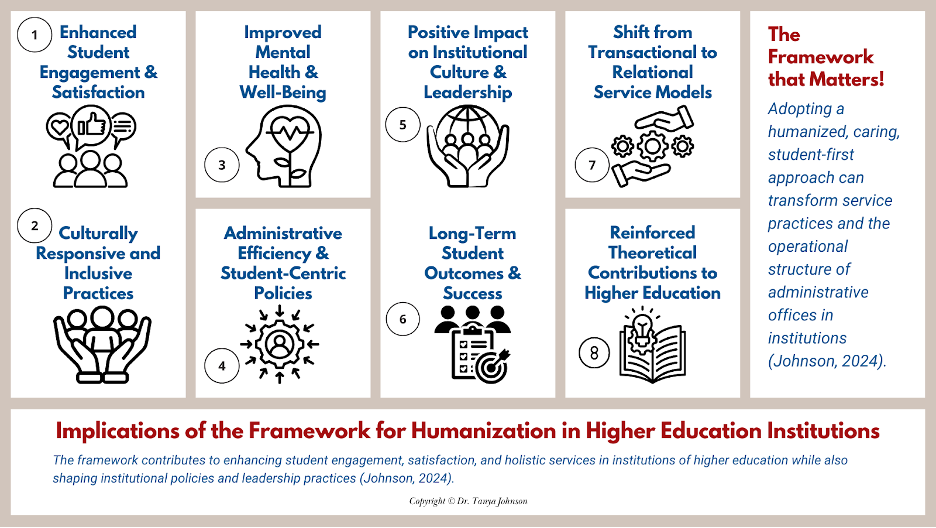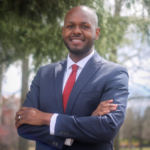
Tanya Johnson, PhD
Senior Administrator at Johns Hopkins University
Founder and Owner of Aspire Pinnacle

Antione D. Tomlin, PhD, PCC
Associate Professor of Academic Literacies, Communications, and English
Anne Arundel Community College
In higher education, students are more than learners—they are individuals navigating complex academic, social, and personal experiences. The Humanization Framework for Higher Education is a transformative model that centers care and empathy at the heart of institutional service practices. Recognizing that a student’s holistic experience directly impacts their academic success and personal growth, this framework calls for an intentional, inclusive service culture. It integrates nine key pillars: empathy, personalization, transparency, exclusivity, consistency, community, crisis management, student prioritization, and a collective service culture. Together, these elements drive a people-first (i.e., human-first) approach to student engagement, creating equitable and meaningful experiences while promoting operational excellence. We note that this approach can be very impactful for faculty and staff supporting students.
Here are the reasons why the nine key pillars of the framework are essential for enhancing operational efficiencies at higher education institutions:
- Empathy ensures that service interactions are rooted in understanding and compassion.
- Personalization tailors support to individual student needs.
- Transparency promotes trust through clear and honest communication.
- Exclusivity ensures that services are designed with intentional inclusivity, recognizing diverse student experiences.
- Consistency upholds reliability and fairness in service delivery.
- Community fosters a sense of belonging through engagement and collaboration.
- Crisis management prepares institutions to respond effectively to student challenges with care and efficiency.
- Student prioritization centers decision-making around student well-being and success.
- Service culture integrates these elements into a cohesive, institutional commitment to human-centered, responsive, and transformative service experiences.
The purpose of this framework is simple but profound: to guide faculty, staff, and administrators in embedding humanistic principles into their daily interactions, policies, and operational decisions. By integrating components such as empathy, personalization, and transparency, the framework is designed to help higher education institutions bridge the gap between transactional service delivery and meaningful connections.
At its core, this framework is more than a model—it is a call to action, a commitment to humanizing the way we serve, lead, and operate within institutions. By embedding empathy, inclusivity, and intentional service into our practices, we create an environment where individuals feel valued, heard, and supported, ultimately transforming operational efficiencies and enriching the human experience.
By emphasizing proactive support, clarity in communication, and a student-centric mindset, the framework ensures that institutions meet students’ academic and personal needs with understanding, reliability, and care. As higher education faces shifting demands and diverse student populations, institutions will not only retain students but help them thrive.
Ultimately, the Humanization Framework reflects a commitment to elevating higher education environments by emphasizing compassion, community, and holistic student engagement. It serves as a blueprint for faculty and staff to build deeper relationships with students, foster belonging, and provide support tailored to the diverse challenges that students face today. This work, driven by a passion for humanization and leadership, stands as a call to action for institutions to center care in their mission to educate and serve.
A Depiction of the Humanization Framework’s Implications

Examples of the Humanization Framework in Practice:
1. Empathy: Understanding Unique Needs
- Scenario: An international student struggles to adapt to both the academic rigor and cultural differences at their institution.
- Application: Staff from the student success center take a compassionate, relational approach by regularly checking in, offering tailored academic support, and connecting the student with cultural affinity groups. Faculty demonstrate empathy by understanding language barriers and providing extra office hours.
2. Personalization: Tailoring Support to Individuals
- Scenario: A student with a disability requires specific accommodations for exams and coursework.
- Application: Advisors collaborate with faculty to design a support plan that suits the student’s needs, including alternative testing options and accessible learning resources. By tailoring interventions, the student builds trust and feels seen by the institution.
3. Transparency: Clear and Navigable Information
- Scenario: A first-generation student is unsure of how to navigate financial aid requirements and deadlines.
- Application: Financial aid officers provide clear, concise instructions through workshops and personalized communication. They also maintain an easily navigable FAQ portal, helping students anticipate key steps and avoid common pitfalls.
4. Exclusivity: Ensuring Equitable and Special Access to Resources
- Scenario: A marginalized student group reports feeling overlooked in campus activities and support services.
- Application: The institution establishes exclusive, safe spaces and targeted programs that meet the specific needs of marginalized populations, such as first-generation, BIPOC, or LGBTQ+ students. This could include mentorship programs, scholarships, and support networks tailored to these groups. By making accommodations and services explicitly available to students who may not feel represented in mainstream services, the institution fosters inclusion while ensuring equitable access to opportunities and resources.
5. Consistency: Reliable and Predictable Service
- Scenario: A student seeking mental health resources faces delays due to inconsistent referral processes.
- Application: The institution implements a clear, streamlined process for all support requests, ensuring predictable and timely responses. Students receive follow-ups to confirm that their concerns have been addressed consistently across departments.
6. Community: Creating a Sense of Belonging
- Scenario: A commuter student feels disconnected from campus life.
- Application: Faculty encourage in-class discussions and group projects that foster peer interaction. The student affairs team invites the student to events tailored for off-campus students, creating an environment that promotes social integration and belonging.
7. Crisis Management: Flexible and Accessible Support
- Scenario: A student experiences a family emergency that interrupts their semester.
- Application: The institution offers flexible deadlines, emergency housing options, and mental health support. Advisors coordinate with professors to provide extensions and accommodations, ensuring the student stays on track academically.
8. Student Prioritization: Gathering Feedback and Refining Practices
- Scenario: Survey data reveals that students feel overwhelmed by administrative processes.
- Application: The institution regularly collects and analyzes student feedback to identify service gaps. In response, it revises service delivery policies, streamlines administrative workflows, and ensures that improvements are communicated to students.
9. Service Culture: Beyond Expectations
- Scenario: Students feel their concerns are often handled in isolation rather than holistically.
- Application: Staff members work across departments using a collective mindset, ensuring all units share responsibility for delivering exceptional service. By integrating academic, financial, and personal support, the institution promotes high-quality outcomes.
Driving Positive Experiences for Higher Ed Students
When we prioritize humanization in our service culture, we do more than improve processes—we affirm the dignity of every individual we encounter. True operational excellence is not just about efficiency; it is about fostering trust, connection, and a sense of belonging that leaves a lasting impact on the communities we serve.
These practical applications demonstrate how higher education faculty and staff can use the Humanization Framework for Higher Education to foster authentic relationships, ensure consistent support, and create lasting positive impacts on the student experience. While the framework provides key elements for service delivery, these examples are not exhaustive. Faculty, staff, and administrators should approach their roles with intentionality, ensuring that the care they provide is thoughtful, adaptable, and rooted in the unique needs of their students. Institutions must prioritize students at the center of service delivery, recognizing that meaningful engagement and compassionate support require a commitment to continuous improvement. Through this intentional practice, we can create learning environments that not only meet students’ academic needs but foster their personal growth and sense of belonging.
Reference: Johnson, T. (2024). Humanization in Higher Education: A Grounded Theory Study on the Impact That Customer Service Practices Have on the Student Academic Journey (Doctoral dissertation, Morgan State University).
Authors Bios:
Tanya Johnson, PhD, is a senior administrator overseeing a university-wide student support operation in America’s first research institution and the founder and owner of Aspire Pinnacle—a leadership and executive coaching firm dedicated to empowering individuals and organizations through human-centered strategies that enhance leadership, operational excellence, and professional growth. Connect on LinkedIn @DrIAspire and @The AspirePinnacle.
Antione D. Tomlin, PhD, PCC, is a tenured Associate Professor and Director of Academic Literacies, Communications, and English at Anne Arundel Community College. Dr. Tomlin is also an ICF Certified Life Coach. Feel free to reach out at www.drantionetomlin.com or on X (Twitter) @Tomlinantione.
Build Your Dossier With Interfolio.
Advance With Confidence.
Applying for academic programs or positions requires many artifacts. Put your best foot forward with Interfolio.
Start building your dossier for free today.
Any opinions, findings, conclusions, or recommendations expressed in this material are those of the authors and do not necessarily reflect the view of Interfolio.
















